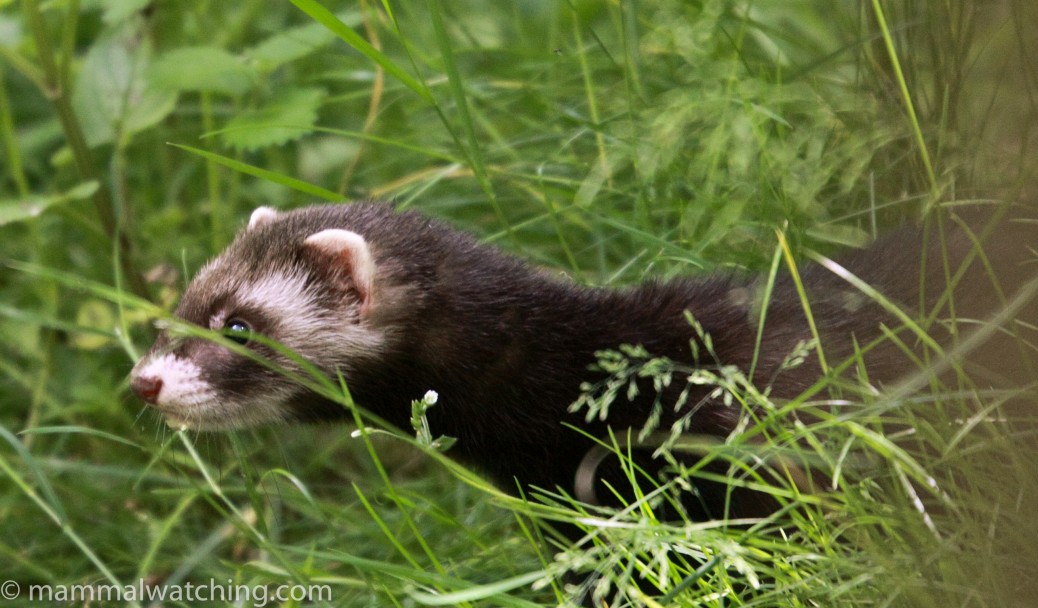
United Kingdom
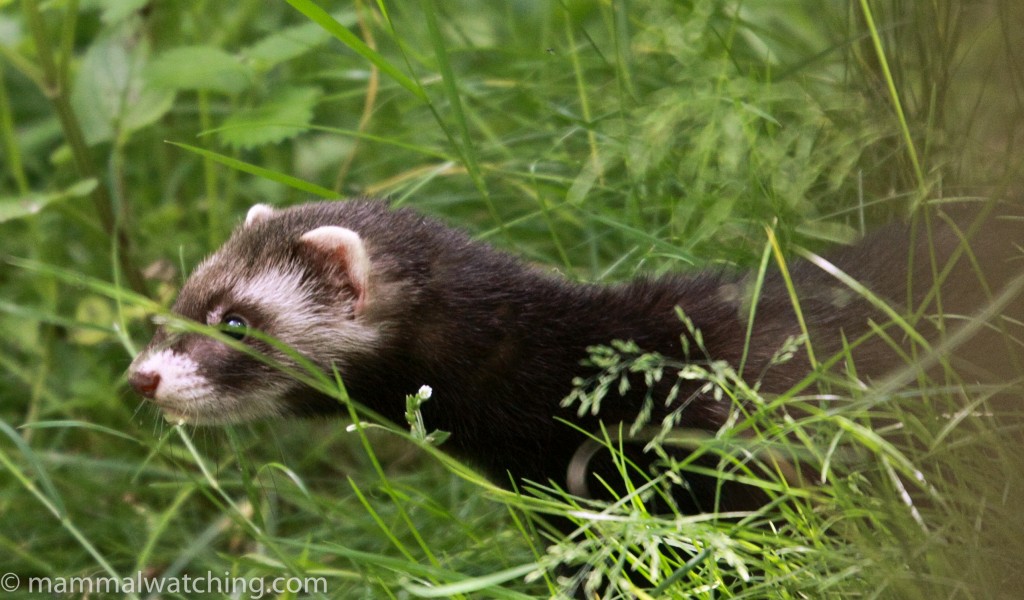
European Polecat, Mustela putorius, Tring, 2009.
I grew up in the UK and spent a good bit of time between 1992 and 1998 looking for mammals there.
Mammal watching is a far cry from that in much of the rest of the world. There are some nice species, but the diversity of mammals is low, and many of the more interesting animals are quite sparsely distributed and/or hard to see (it is difficult to find anywhere in the UK without perpetual disturbance from people). There aren’t many places that are particularly good for seeing mammals generally: the Ardnarmuchan Peninsula is one of the best and Richard Webb’s report has some useful information.
I’ve included here some brief notes on the individual species I’ve seen and where to see them. A lot of people are working on the country’s mammals (many of them volunteers) and if you can meet the local experts it is often possible to arrange to take part in fauna surveys etc.
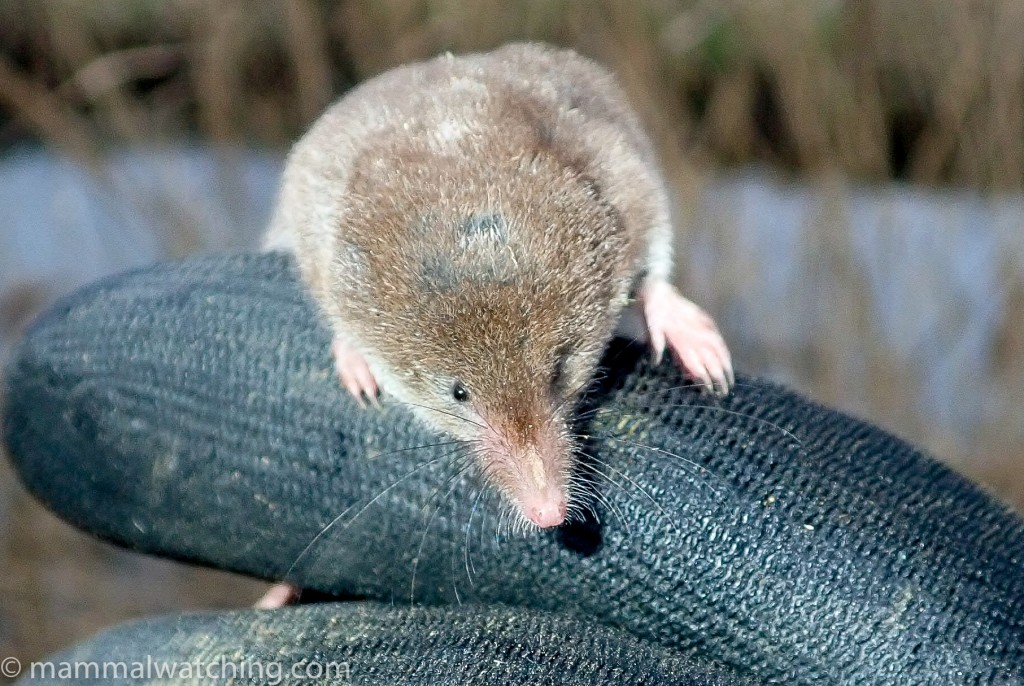
Common Shrew, Sorex araneus. Ely, 2022
There is a lot of information on where to find species on the Internet. The National Biodiversity Network is a good website which has lots of useful information. The People’s Trust for Endangered Species run some quite nice mammal watching activities each year. Their trips are a good way to see some of the bats and smaller mammals.
European Rabbits are everywhere, and European (Brown) Hares are also fairly common in many parts of the country (Wiltshire seems a good area for them for example). I saw a Mountain Hare once in Scotland on the Isle of Mull. Shetland, north of Lewick, is apparently a good place to see this species as is Glenshee in the Grampians.
Feral Eastern Grey Squirrels are very common, just look in any of the London parks. The Red Squirrel has declined dramatically. Brownsea Island (Dorset) is one of the best places to see them, though they still persist in parts of Scotland and small bits of England (e.g. pine forests around Formby) and Wales.
The European Water Vole has also declined dramatically. I haven’t seen one since I was a kid, but then I haven’t really been looking. Field Voles are one of the UK’s most common mammal though rarely seen unless trapping in suitable habitat (fields – surprisingly). Bank Voles are more commonly seen and often trapped in almost any suitable habitat.
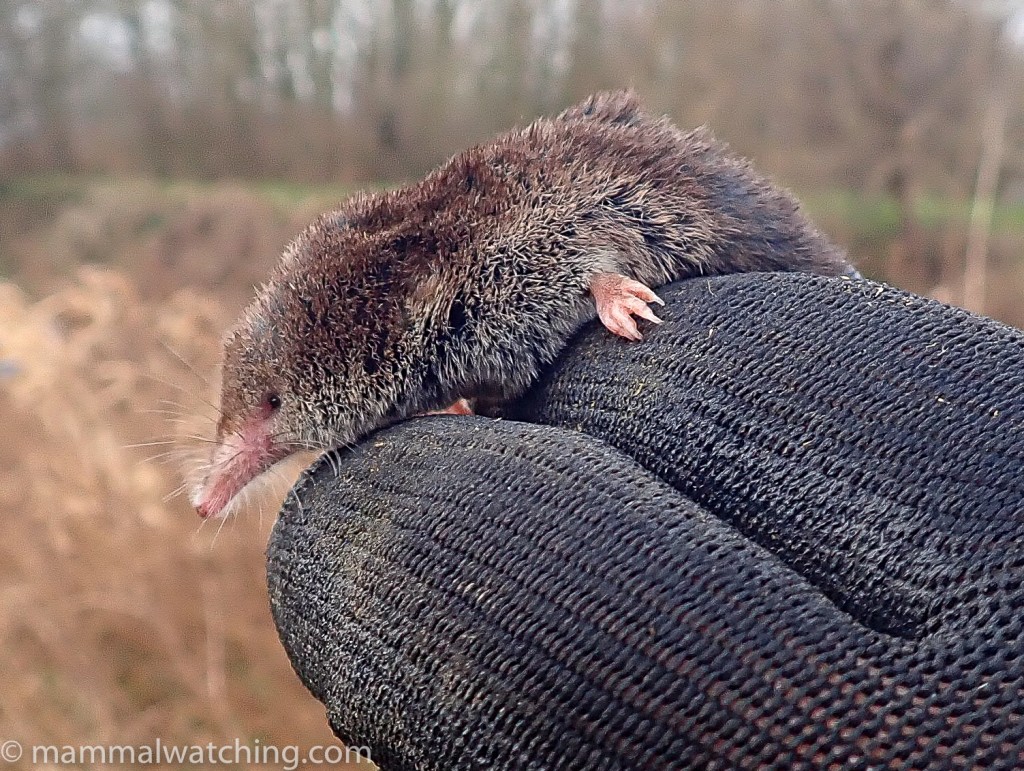
Eurasian Pygmy Shrew, Sorex minutus. Ely, 2022.
Shrews (Common, Pygmy and Water) are relatively easy to catch in British Longworth live traps. They seem to enter these traps more readily than American Sherman traps for instance. Perhaps because they like the traps smaller entrance tunnels. I am guessing here but I don’t see what other else might be the reason.
Wood Mice are common in many areas and can sometimes be seen on bird feeders. We had one visit our London garden regularly in the day time. Yellow-necked Mice are also common in some areas, though their range is more limited. I saw my first in the UK in 2022 with Mark Hows in Cambridgeshire.
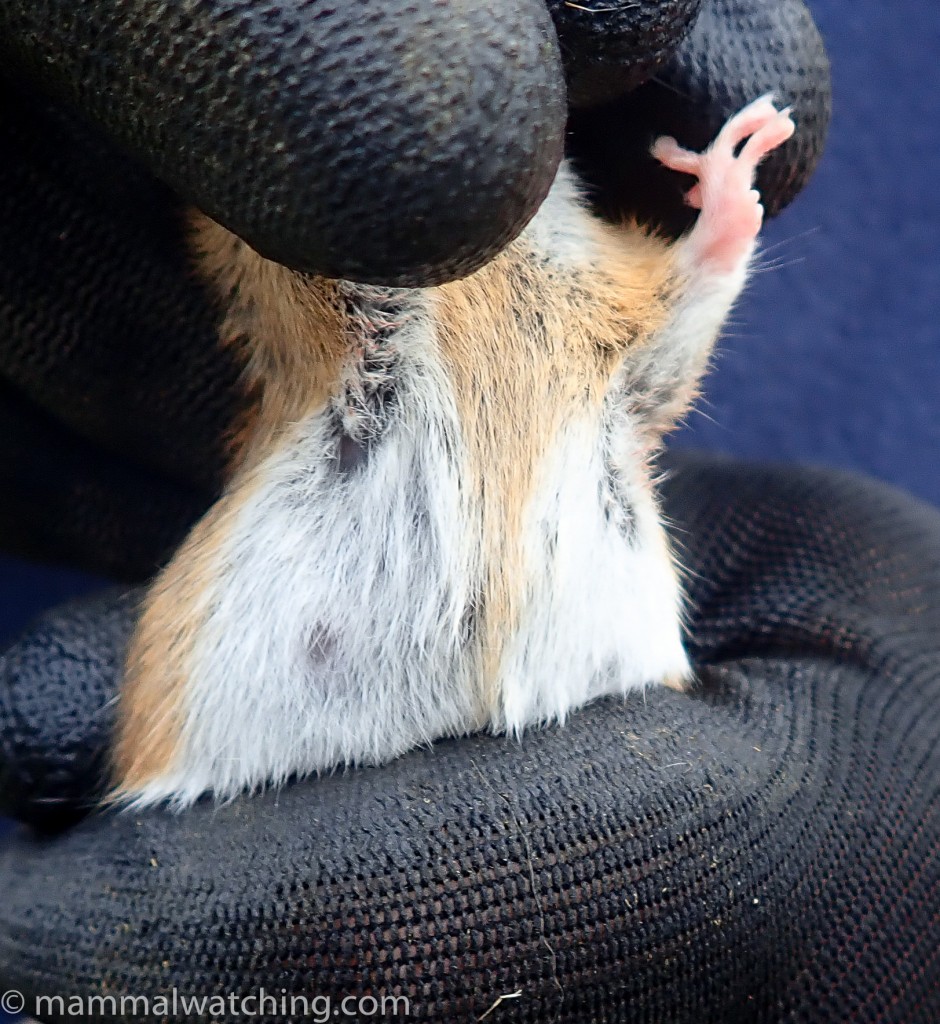
Yellow-necked Mouse, Apodemus flavicollis. Ely 2022.
Harvest Mice and Hazel Dormice are lovely little things. I’ve seen each species only the once. I saw Harvest Mice when I helped with a trapping study near Welwyn Garden City. And I saw Hazel Dormice when I helped check nest-boxes in Gloucestershire. If you want to get involved in such projects then you might start with the PTES. Wood Mice are often seen and trapped – they used to visit the bird feeder in my London garden. Feral Fat Dormice can be spotlit in Ashridge Forest near Tring.
Red Foxes are common throughout the country, but most common in the suburbs of the larger cities. The scottish Wild Cat may no longer truly exist in the wild (remaining animals may be the results of interbreeding with domestic cats). The wild animals that remain are rarely seen, but are scattered across the highlands of Scotland.
Harbour Seals are common around the coastline. Grey Seals are more restricted. You can see both species easily in Norfolk for example.
I think the mustelids are the most exciting group of mammals in the UK. Weasels and Stoats are very occasionally seen on drives through the country. Both like to den in dry stone walls. An excellent place to see Stoats is Mount Grace Priory in North Yorkshire, where a colony of Stoats live in the priory ruins. They respond well to ‘rabbit in distress’ style squeaking.
The Pine Marten is a beautiful animal and returning quite strongly in certain areas, like the Ardnarmurchan peninsula in Scotland. If you spend a few days there you ought to come across them. Some animals feed regularly at bird tables in the area (they seem to enjoy most food but are partial to jam sandwiches).
Polecats are probably commonest in North Wales, though difficult to find. I’ve only seen roadkill there though eventually saw one near London. Others have had luck however and John Dixon from the UK recommends putting in four or five hours spotlighting around the Usk reservoir. He says “Personally I would say there are three areas to concentrate on: The Lleyn peninsula in North-west Wales; the already mentioned Usk Res environs, and the forested parts of Cheshire. They are so elusive. I talked to the manager of the Gigrin Farm Red Kite feeding station who told me one year Polecats bred underneath the kite viewing hide but nobody knew until he cut back nettles in front of the hide and flushed the family.
In June 2009 I eventually saw an animal that was one of a family of five that were being seen regularly from a birding hide at College Lake Nature Reserve near Tring, north west of London. They were most active in late May/early June when the youngsters were about.
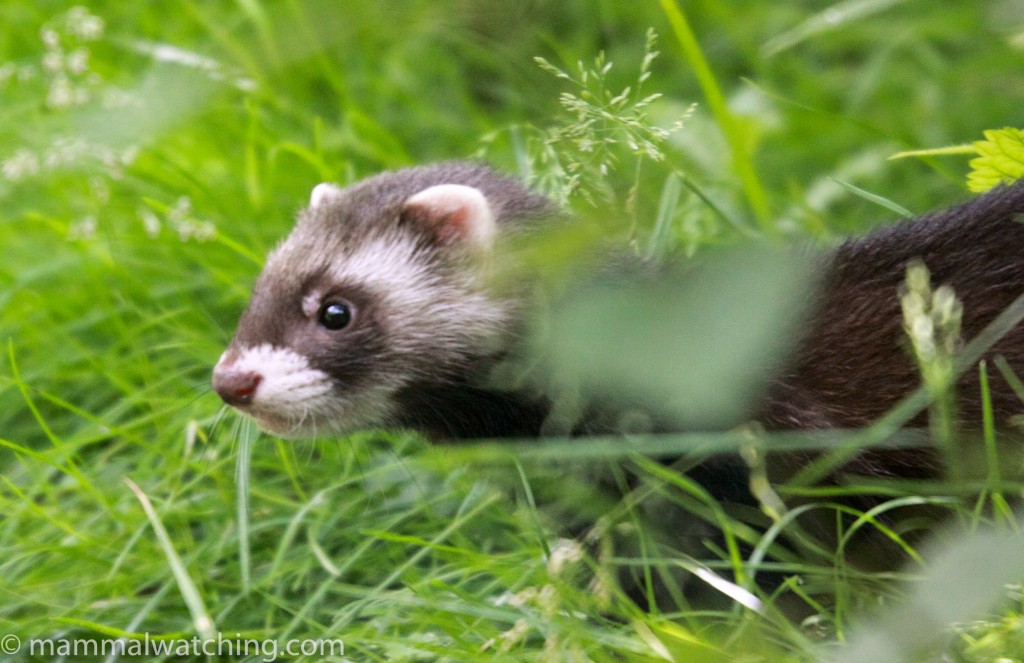
European polecat, Mustela putorius, College Lake, Tring, 2009.
Otters are apparently making a bit of a comeback and easiest to see in the Scottish highlands, especially around the coast where they are more diurnal than in other, busier places. The Isle of Mull is a good spot. In 2008 I was told that Druridge Pools, a spot in Northumberland (in the UK’s north east) is a very good site for Otters even during the daytime when animals can be spotted in a matter of minutes.
Badger watching is a popular pastime. Its something you can do in many parts of the country.
Hedgehogs are common, and I’ve seen them most often in suburbia, though hard to find when you want to see one! Moles are also common – you’ll see their diggings all over the place but they spend most of their time underground and I have only ever seen one in the wild. Common, Pygmy and Water Shrews are all best found in traps, though you can occasionally see Common and Water Shrews at any hour of the day or night.
Britain only has 17 species of Bats, and most can reliably be identified using a basic bat detector. Even in the middle of London, you can find a few species (e.g. Pipistrelles, Natterers, Daubentons). Roost locations are less closely guarded secrets than they used to be (obviously if you do visit a roost to watch the bats emerge at dusk you should not get too close or visit on successive nights – repeated disturbance can lead to the bats moving elsewhere) and you should not enter the roost space itself. Many parts of the UK have local bat groups who run events, see the Bat Conservation Trust for more info. The People’s Trust for Endangered Species also run some bat evenings focussed on certain species. In August 2007 I went to Petworth, West Sussex to try to see Bechstein’s Bats which are pretty rare in the UK but roost in woodland there. The Bechsteins didn’t show (it has been a bad year for them) but we had a look at Barbastelles leaving a bat box, and caught Whiskered, Natterers, Brown Long-eared and Soprano Pipistrelles in harp traps.
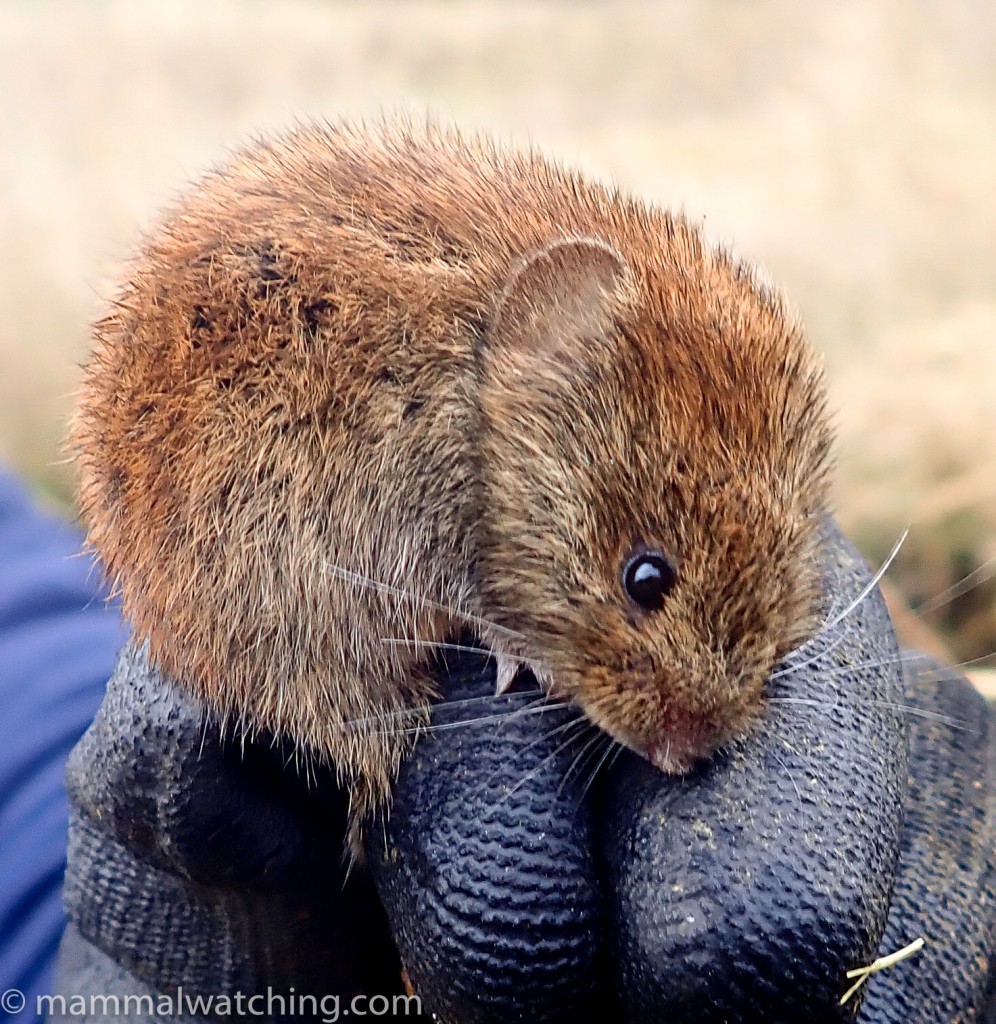
Bank Vole, Clethrionomys gareolus. Ely, 2022.
Cetacean spotting in the UK is best up in Scotland. Minke Whale watching is run out of the Isle of Mull, where Harbour Porpoises are common, and Risso’s Dolphins occasionally seen. Short-beaked Common Dolphins are regular in these waters too. Head a bit further north on the west coast (up to Gairloch for example) and keep your eyes open for Atlantic White-sided and White-beaked Dolphins (I’ve only seen the latter). There are a well studied group of offshore Bottlenose Dolphins (Tursiops truncatus) in the Moray Firth.
Reeves’ Muntjak Deer (feral) are common in many areas, especially the outskirts of London. Red Deer are throughout the highlands of Scotland. Fallow and Roe Deer are scattered around the country (easiest to see in Scotland I guess) and Sika Deer are expanding their range. They can be found in Scotland, and in the south of England (eg. Dorset). Feral Chinese Water Deer are easy to see around the Norfolk Broads in Strumpshaw Fen and Stubb Mill near Horsey.
Community Reports
Various UK trip reports are included in John Dixon’s threads on the UK Bird Forum. They are difficult to link to so Google “John’s Mammals Bird Forum” to find them.
Scotland, 2023: Ruben Vernieuwe, 3 weeks & 15 species including Humpback Whale, White-beaked Dolphin and Common Shrew.
England, 2022: Olli Haukkovaara, 1 week & 20 species including Noctule, Short-tailed Vole, Hedgehog and Minke Whale.
Scottish Highlands, 2021: Naturetrek, 8 days & 13 species including Pine Marten, Otter and Harbour Porpoise.
Scottish Highlands, 2021: Hugh Lansdown, 8 days & 10 species including Beaver, Mountain Hare and Field Vole.
Forest of Dean, 2020: Naturetrek, 2 days & 5 species including Badger and Yellow-necked Mouse.
Hampshire Small Mammal Days, 2020: Naturetrek, several small mammal trapping day trips with species including Pygmy and Common Shrew and Harvest Mice.
Devon, 2020: Devon Beaver & Wildlife Tours report of a European Beaver safari.
Mull, 2020: Hugh Lansdown, 2 nights & 10 species including Risso’s and Common Dolphins.
Ardnamurchan Peninsula, 2019: John Wright, 6 days & 13 species including Pine Marten, Badger and Harbour Porpoise, but no Wild Cat.
Shetland, 2018: Mark Hows, 1 week & 9 species including Orca and Bearded Seal.
England, 2018: Vladimir Dinets, 10 days with species including Badgers, Water and Pygmy Shrews and Exmoor Ponies.
Scotland-Spitsbergen, 2018: Dominique Brugiere, 16 days and 16 species on the cruise including Hooded Seals, Walrus and Bottlenose Whales, plus another 12 species in Scotland.
Scotland, 2018: John Wright, 5 days & 16 species including Least Weasel, Pine Marten and Red-necked Wallabies.
UK Mammals in 2017: John Wright’s account of a year’s British mammaling with 47 species including multiple Otters, Least Weasels, Beavers, Water Shrews and a Humpback Whale.
Tayside Beavers, 2017: James Lowen’s report on seeing European Beavers in Scotland.
Scottish Beavers, 2017: Matthew and Maureen Hart, 4 days & 8 species including European Beaver.
Scotland, 2015: Mike Hoit’s report of a day or two in Perthsire and Mull, with highlights including Pine Marten and European Beaver.
Scotland, 2015: Richard Webb’s report of 2 days in Perthshire to see European Beaver and 5 other species including Mountain Hare and Eurasian Otter.
England, 2015: Stefanie Lahaye, 5 days & 15 species including Water Shrew, Harvest Mouse, Weasel and Otter.
Big Mammal Day (Norfolk), 2014: Richard Moore’s account of an impromptu 19 hours around Norfolk which netted 25 species (despite spending some of the time in the office!) including Western Barbastelle Bats and Yellow-necked Mice.
Scotland & Northern England, 2014: Steve Morgan, 10 days & 13 species including Minke Whales and Water Voles.
Scotland, 2013: Mark Hows, 1 fun week search for a Black Rat, with an impressive 29 mammals including White-beaked Dolphin, Pine Marten, Wild Cat and Black Rat,
Scotland, 2013: Cheryl Antonucci, 1 week & 11 species including Pine Marten and European Beaver.
Jersey, 2013: Mark Hows, 5 days & 6 species including a Lesser White-toothed Shrew.
Scotland, 2012: Mark Hows, 1 week & 18 species including White-beaked and White-sided Dolphins and a Pine Marten.
Isle of Man, 2010: Mark Hows, 3 days & 7 species including Red-necked Wallabies and a Polecat/Ferret.
Orkney, 2010: Mark Hows, 1 week & 16 species including a Common Vole and a Bearded Seal.
Ardnarmurchan Peninsula, Scotland 2009: Mike Richardson, 1 week and 17 species including a Wild Cat this time.
Cornwall and the Scilly Isles, 2009: Mark Hows, a few species including a Scilly (Lesser White-toothed) Shrew.
Scotland, 2008: Mark Hows, 1 week & 31 species (!) including a Wildcat.
Speyside and Ardnarmurchan, Scotland 2008: Mike Richardson, 1 week and 16 species including a Pine Marten and probable Wild Cat.
Northern Ireland, 2008: Mark Hows, 4 days & 8 species including Black-tailed Prarie Dogs and a Nathusius’s Pipistrelle.
The Ardnarmurchan Peninsula, Scotland: detailed notes from Richard Webb about the mammals there, including Scottish Wildcats.
Also See
RFI mammal sites in southern England, March 2025
RFI mammals around England, September 2024
Pine Marten hide, Perth, Scotland, August 2019
RFI London, April 2009)
RFI England, February 2009
Resources
Moores, Richard, 2007. Where to Watch Mammals in Britain and Ireland. A&C Black, London. If every country had a book like this then the world would be a better place! The book includes information on 200 or so of the best places in the UK and Ireland to watch mammals and cross references these against every mammal species known to occur. It also includes list of various mammal related organisations in the UK.
The People’s Trust for Endangered Species run trips to see various wildlife in the UK (eg., helping with mammal trapping and bat work) and overseas.


Leave a Reply
You must be logged in to post a comment.